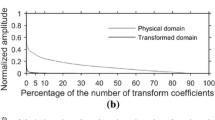Abstract
A new multiple-point statistics algorithm, SparseSim, is developed based on sparse approximation algorithm, which has wide applications for stochastic simulation in the field of geosciences and beyond. The current version is described in the context of reservoir characterization, which includes well and seismic data integration. In sparse approximation, a model image is represented as weighted linear combination of columns of the dictionary matrix. For this purpose, a parsimonious subset of the dictionary columns and their corresponding weights are selected using sparse coding methods. The dictionary is obtained by dictionary learning algorithms trained over and adapted for specific types of model images in the training set. Based on the sparse approximation algorithm, the approximated model image is generated by multiplication of the dictionary and the weight matrices. Intuitively, stochastic simulation of the coefficient (weight) matrix will lead to generation of new stochastic realizations. The SparseSim algorithm, as represented in this paper, works based on extracting the trend for nonzero elements in the significant rows of the weight matrix, and it is proposed under two general schemes: stochastically simulating the details of the training image or stochastically simulating both the details and the mean value of the training image. It is shown in this paper that under both schemes the generated realizations, while stochastically distinct, are similar to each other and to the training image. Different aspects of the SparseSim algorithm such as SparseSim in 3D, SparseSim in different scales, and data conditioning are also discussed.





























Similar content being viewed by others
Availability of Data and Materials
Data and material can be made available by emailing the author.
Code Availability
The author might share the code under certain conditions.
References
Arpat, G. B. (2005). Sequential simulation with patterns. Ph.D. thesis, Stanford University, Stanford, CA, USA.
Bembenik, R., Skonieczny, Ł, Protaziuk, G., Kryszkiewicz, M., & Rybinski, H. (2019). Intelligent methods and big data in industrial applications. Springer. https://doi.org/10.1007/978-3-319-77604-0
Chatterjee, S., Dimitrakopoulos, R., & Mustapha, H. (2012). Dimensional reduction of pattern-based simulation using wavelet analysis. Mathematical Geosciences, 44, 343–374.
Efron, B., Hastie, T., Johnstone, I., & Tibshirani, R. (2004). Least angle regression (with discussion). Annals of Statistics, 32(2), 407–499.
Elad, M. (2010). Sparse and redundant representations, from theory to applications in signal and image processing. Springer.
Engan, K., Aase, S. O., & Husøy, J. H. (1999a). Method of optimal directions for frame design. In IEEE international conference on acoustics, speech, & signal process (Vol. 5, pp. 2443–2446).
Engan, K., Rao, B. D., & Kreutz-Delgado, K. (1999b). Frame design using focuss with method of optimal directions (MOD). In Proceedings of Norwegian signal processing symposium (Vol. 65–69).
Honarkhah, M. (2011). Stochastic simulation of patterns using distance-based pattern modeling. Ph.D. thesis, Stanford University.
Hosseini, M. (2021). Using total variation method to estimate the permeability model of a gas-fingering area in an Iranian carbonate reservoir. Acta Geophysics. https://doi.org/10.1007/s11600-021-00573-x
Hosseini, M., & Riahi, M. A. (2019a). Detecting a gas injection front using a 3D seismic data: Case of an Asmari carbonate reservoir in the Zagros basin. Carbonates and Evaporites, 34, 1657–1668. https://doi.org/10.1007/s13146-019-00514-2
Hosseini, M., & Riahi, M. A. (2019b). Using input-adaptive dictionaries trained by the method of optimal directions to estimate the permeability of a reservoir. Journal of Applied Geophysics, 165, 16–28.
Khaninezhad, M. R., & Jafarpour, B. (2018). Field-scale history matching with sparse geologic dictionaries. Journal of Petroleum Science and Engineering, 170, 967–991.
Mariethoz, G., & Caers, J. (2015). Multiple-point geostatistics: Stochastic modeling with training images. Wiley.
Mariethoz, G., & Renard, P. (2010). Reconstruction of incomplete data sets or images using direct sampling. Mathematical Geosciences, 42(3), 245–268.
Saggaf, M., & Toksoz, N. (2003). Seismic facies classification and identification by competitive neural networks. Geophysics, 68, 1984–1999.
Scheidt, C., Li, L., & Caers, J. (2018). Quantifying uncertainty in subsurface systems. Geophysical monograph series (Vol. 236). Wiley.
Strebelle, S. (2000). Sequential simulation drawing structures from training images. Ph.D. thesis, Stanford University.
Zhang, T. (2006). Filter-based training pattern classification for spatial pattern simulation. Ph.D. thesis, Stanford University.
Acknowledgments
This research has not received any grant from any for-profit or non-for-profit institution or organization. This research is designed and performed by the author as part of a broader self-motivated and self-derived research study independently from any individual or organization and only consulting the references. I greatly appreciate the research works of other scientists cited in this article which have paved the way for further developments and discoveries.
Author information
Authors and Affiliations
Corresponding author
Rights and permissions
About this article
Cite this article
Hosseini, M. SparseSim: Stochastic Simulation and Modeling Based on Sparse Approximation and Dictionary Learning. Nat Resour Res 30, 3503–3532 (2021). https://doi.org/10.1007/s11053-021-09887-5
Received:
Accepted:
Published:
Issue Date:
DOI: https://doi.org/10.1007/s11053-021-09887-5




